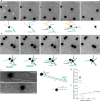Adhesion pilus retraction powers twitching motility in the thermoacidophilic crenarchaeon Sulfolobus acidocaldarius
- PMID: 38877024
- PMCID: PMC11178785
- DOI: 10.1038/s41467-024-49101-7
Adhesion pilus retraction powers twitching motility in the thermoacidophilic crenarchaeon Sulfolobus acidocaldarius
Abstract
Type IV pili are filamentous appendages found in most bacteria and archaea, where they can support functions such as surface adhesion, DNA uptake, aggregation, and motility. In most bacteria, PilT-family ATPases disassemble adhesion pili, causing them to rapidly retract and produce twitching motility, important for surface colonization. As archaea do not possess PilT homologs, it was thought that archaeal pili cannot retract and that archaea do not exhibit twitching motility. Here, we use live-cell imaging, automated cell tracking, fluorescence imaging, and genetic manipulation to show that the hyperthermophilic archaeon Sulfolobus acidocaldarius exhibits twitching motility, driven by retractable adhesion (Aap) pili, under physiologically relevant conditions (75 °C, pH 2). Aap pili are thus capable of retraction in the absence of a PilT homolog, suggesting that the ancestral type IV pili in the last universal common ancestor (LUCA) were capable of retraction.
© 2024. The Author(s).
Conflict of interest statement
The authors declare no competing interests.
Figures




Update of
-
Sulfolobus acidocaldarius adhesion pili power twitching motility in the absence of a dedicated retraction ATPase.bioRxiv [Preprint]. 2023 Aug 4:2023.08.04.552066. doi: 10.1101/2023.08.04.552066. bioRxiv. 2023. Update in: Nat Commun. 2024 Jun 14;15(1):5051. doi: 10.1038/s41467-024-49101-7. PMID: 37577505 Free PMC article. Updated. Preprint.
References
MeSH terms
Substances
Grants and funding
LinkOut - more resources
Full Text Sources
Research Materials
Miscellaneous

